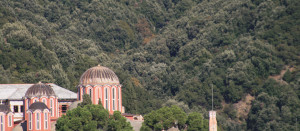
I. Basil bizánci császár kizárólagos belépési jogot adott a szerzeteseknek az Athos-hegy félszigetére. 885 HIRDETÉS. Virágzó vallási közösséget építettek, és azóta is fenntartják és védik az ökoszisztémát. Kezelésük túlnyomórészt a belépés ellenőrzéséből és a faanyagok szabályozásából áll. A félsziget hivatalosan az UNESCO Világörökség része és Natura 2000 telek, de mindkét megnevezést nem a szerzetesekkel való konzultáció alapján állították fel. Mindazonáltal, a 1926 a görög alkotmány elismerte, hogy a szerzetesek teljes mértékben felelősek a helyszín kezeléséért.
A keleti ortodox kereszténység helyén összesen húsz kolostor található. A szerzetesek spirituális jelentőséget tulajdonítanak a hegy ökoszisztémájának, és isteni céljuknak tekintik annak védelmét. A kolostorok energiaszükségletükből is önellátóak, és saját maguk állítják elő élelmiszereik és gyógynövényeik egy részét.. Az autonóm kolostorok a Szent Közösség nevű együttműködés vezérelve a természet védelméért dolgoznak.

Ez a kolostor egy domb hátterében áll, beleértve a Holmi és a magyar tölgyeseket. Ezek az erdők nemcsak ökológiai szempontból fontosak, hanem előrevetíti a nagyon szükséges építőanyagokat és a gazdasági bevételt a hegyi szerzetesközösségek számára. Athos
A szerzetesek együtt dolgoznak tudósokkal, hogy ismereteket szerezzenek az olyan helyspecifikus ökoszisztéma-fenyegetésekről, mint például az erdőtüzek és a talajelvonás.. Például: Az ökológiai tanulmányok tájékoztatják a szerzeteseket arról, hogy mely fafajták fákat vágják ki, és hogyan csökkentsék a tűzveszélyt. A szerzetesek aktív hajlandósága és folyamatos elkötelezettsége a terület védelme iránt, lehetőséget ad a további együttműködésre más nemzetközi szereplőkkel., mint például az UNESCO és az IUCN.
Mr. Thymio Papayannis tanácsadója volt a Szent Közösségnek természetvédelmi kezeléssel kapcsolatban, és együtt Mr. Josep-Maria Mallarch koordinálja a Delos Kezdeményezés aki második workshopját tartotta a félelmetes természeti területek kezeléséről a Mt. Athos. A helyszín történetével vagy az ökológiai vizsgálatok eredményeivel kapcsolatos további részletekért lásd weboldalunkat.
által: Rianne Doller






